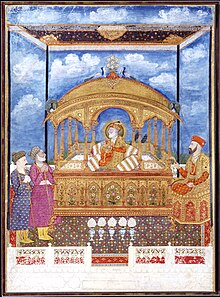- Description by Jean-Baptiste Tavernier
The French jeweler Jean-Baptiste Tavernier made sixth voyage to India between 1663 and 1668. It was a great privilege that he was invited to visit the court at Delhi by emperor Aurangzeb himself, where he remained as his guest for two months from September 12, 1665 to November 11, 1665.
The main purpose of Tavernier's invitation to court was for the emperor to inspect the jewels Tavernier had brought from the west, with an interest of purchasing them. During this visit Tavernier not only sold several jewels to the emperor and his uncle Jafar Khan, but established a close relationship with the emperor that allowed him to stay longer in Delhi. He was invited to stay on until the conclusion of the emperor's annual birthday celebrations, and he also got the opportunity to visit the Red Fort, and inspect the Peacock Throne. He was also given the opportunity to inspect the valuable jewels and stones belonging to the emperor, but was not able to see those still kept by Aurangzeb's father Shah Jahan, who was imprisoned at Agra Fort. A few months after Tavernier inspected the jewels in Aurangzeb's possession, Shah Jahan died in January 1666 and Aurangzeb claimed the remaining inheritance.
Tavernier gives a detailed description of the Peacock Throne in his book Les Six Voyages de J. B. Tavernier, published in 1676 in two volumes. The account of the throne appears in Chapter VIII of Volume II, in which he describes the preparations for the emperor's annual birthday festival, and also the magnificence of his court. Though it should be noted that Tavernier is considered among the least reliable from a conventionally historical perspective.[29][30]
Tavernier however describes seeing the throne in what is probably the Diwan-i-Am. One of the theories is that the throne was sometimes moved between the two halls, depending on the occasion. He further describes five other thrones in the Diwan-i-Khas.
Discrepancies in description[edit]
The descriptions of Lahori from before 1648, and Tavernier's published in 1676 are generally in broad agreement on the most important features of the thrones, such as its rectangular shape, standing on four legs at its corners, the 12 columns on which the canopy rests, and the type of gemstones embedded on the throne, such as balas rubies, emeralds, pearls, diamonds and other coloured stones. There are however some significant differences in the two descriptions:
- Lahori's account of the throne, based on the language used, could be a description of the projected design. Tavernier's account of the throne seems to be an eye-witness observation during his visit in 1665 to the Red Fort. It could be that there were differences between the projected and the final throne that Shah Jahān ascended for the first time on March 12, 1635.
- According to Lahori, the throne was to have a length of 3 yards (9 feet) and a breadth of 2½ yards (7½ feet). Tavernier however gives the length at 6 feet and breadth at 4 feet. The height is described by Lahori as 5 yards (15 feet), but Tavernier's account does not mention its total height. Only the height of the four legs at the corners are mentioned, which was about 2 feet.
- Lahori describes the canopy to be supported by 12 emerald columns, Tavernier describes 12 columns that were surrounded and embedded with rows of pearls, which were round and of fine water, and weighed from 6 to 10 carats each. He thinks these were in fact the most costly and precious aspect of the throne.
- A major difference is the position of the name-giving peacock statues. Lahori states that on the top of each pillar there were to be two peacocks, thick-set with gems, and between each two peacocks, a tree set with rubies and diamonds, emeralds and pearls. If the reference to "pillar" here means "columns" there would be 24 peacocks right round the throne. Tavernier however saw only a single large peacock above the quadrangular-shaped, dome-like canopy, with an elevated tail, embedded with blue sapphires and other coloured stones, and the body of the peacock, made of gold inlaid with precious stones, having a large ruby in front of the breast, from which hangs a pear-shaped pearl around 60 carats in weight. Apart from the single large peacock, Tavernier's account speaks of a large bouquet, consisting of many kinds of flowers, made of gold inlaid with precious stones, of the same height as the peacock, situated on either side of the peacock.
- According to Lahori, the ascent to the throne was to consist of three steps, also set with jewels of fine water. Tavernier however describes four steps on the longer side of the throne and embedded with the same type of gemstones used on the throne, and with matching designs.
Apart from the significant differences between the two accounts given above, there are several details given in Lahori's account, which are not mentioned in Tavernier's, and vice versa.




No comments:
Post a Comment